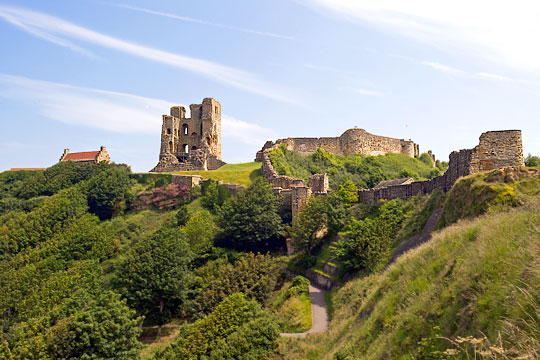Research on Scarborough Castle
Some aspects of the castle's history are well established. What is known of the earlier history of the Scarborough headland, however, is exclusively derived from objects and features revealed by archaeological investigation, and there is plenty of scope for further study.

Research to Date
Information about the site through prehistory and the Roman period is exclusively derived from the objects and features revealed by excavation, which has so far concentrated on the eastern extreme of the headland around the Roman signal station.
Recent research has questioned whether there was a Viking settlement at Scarborough as has long been supposed.[1] The principal evidence for it comes from several Icelandic sagas – in particular, a description of an attack on Scarborough by the Norwegian king, Harald Hardrada, in 1066.[2]The most fulsome account of this attack, however, was not compiled until the 13th century, and there is no clear archaeological evidence for any Viking occupation in the area of the town.
The upstanding medieval fabric of the castle is relatively well recorded and studied. Similarly, the broad outline of the castle's documentary and political history to the present is now well established. There has also been research into the relationship of the town and castle from the 12th century onwards.[3] To date the archaeological investigation of the headland and castle ditches has been limited in scope. Together they present a huge area for investigation.
Research Gaps
There are many subjects about which it would be helpful to know more. A selection of the most important areas which would benefit from further research includes:
- the surviving archaeology of the headland and castle ditches
- Iron Age occupation of the headland
- the erosion of the headland and an appreciation of how the headland may have changed shape during its human occupation
- the nature and extent of Roman occupation associated with the watchtower
- the nature of Viking settlement at Scarborough
- the development of the signal station as a chapel and the evolution of this site
- the wider purposes of the huge Angevin investment in the castle and town of Scarborough
- the early form of the inner bailey and the quadrangle identified by resistivity survey
- the late medieval life of the castle, its officers and occupation
- the nature of Richard III's plans for Scarborough
- the Civil War sieges
- the use of the castle as a barracks, prison and tourist destination from the 18th century onwards.
READ MORE ABOUT SCARBOROUGH CASTLE
Footnotes
1. T Pearson, Scarborough: A History (Chichester, 2009), 7–12.
2. AL Binns, 'Scarborough 1066', in Scarborough 966–1966, ed M Edwards, Scarborough and District Archaeological Society Research Report 6 (1966), 17–23.
3. T Pearson, The Archaeology of Medieval Scarborough: Excavation and Research 1987–2004, Scarborough and District Archaeological Society Research Report 12 (2005), 6–15.